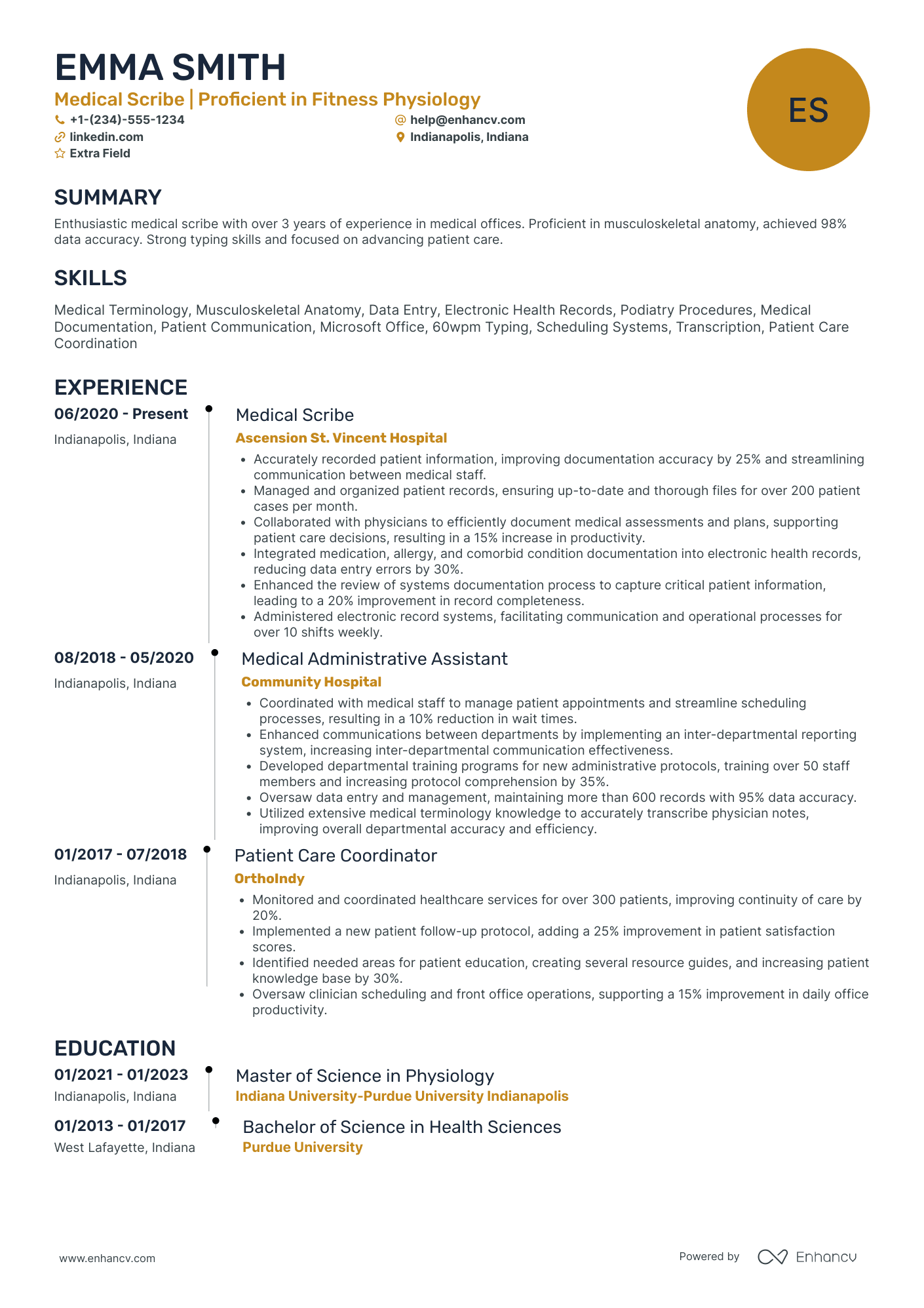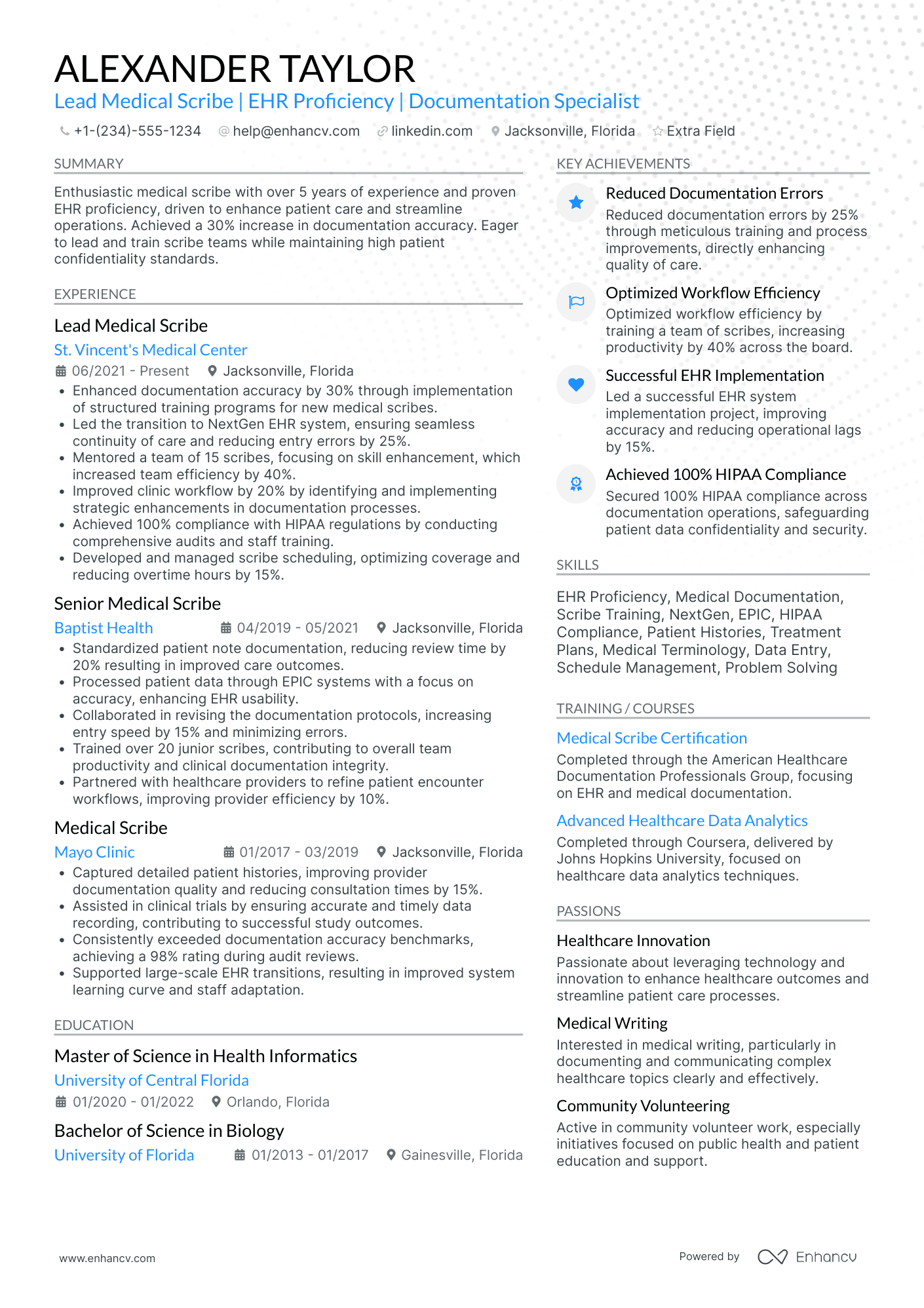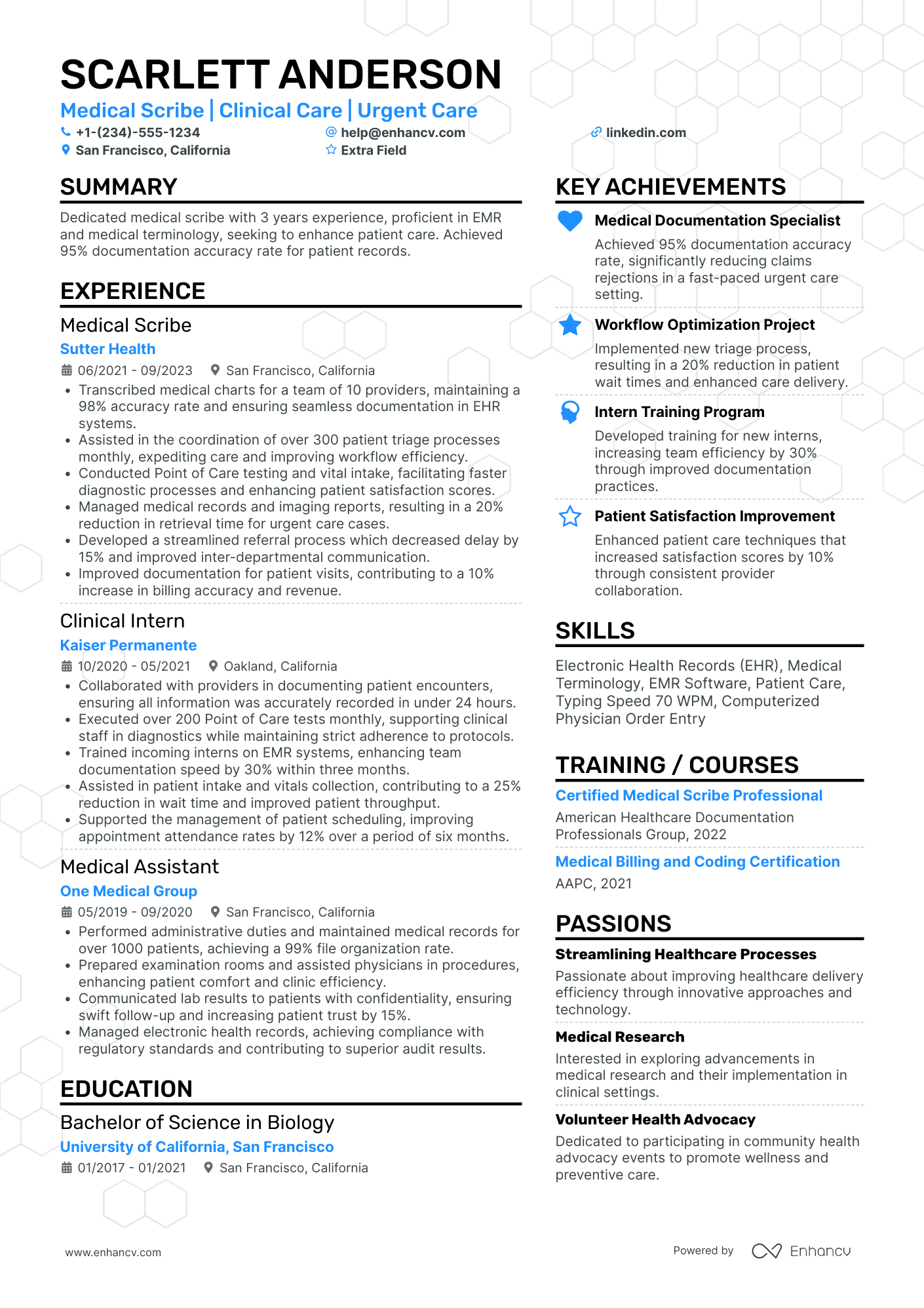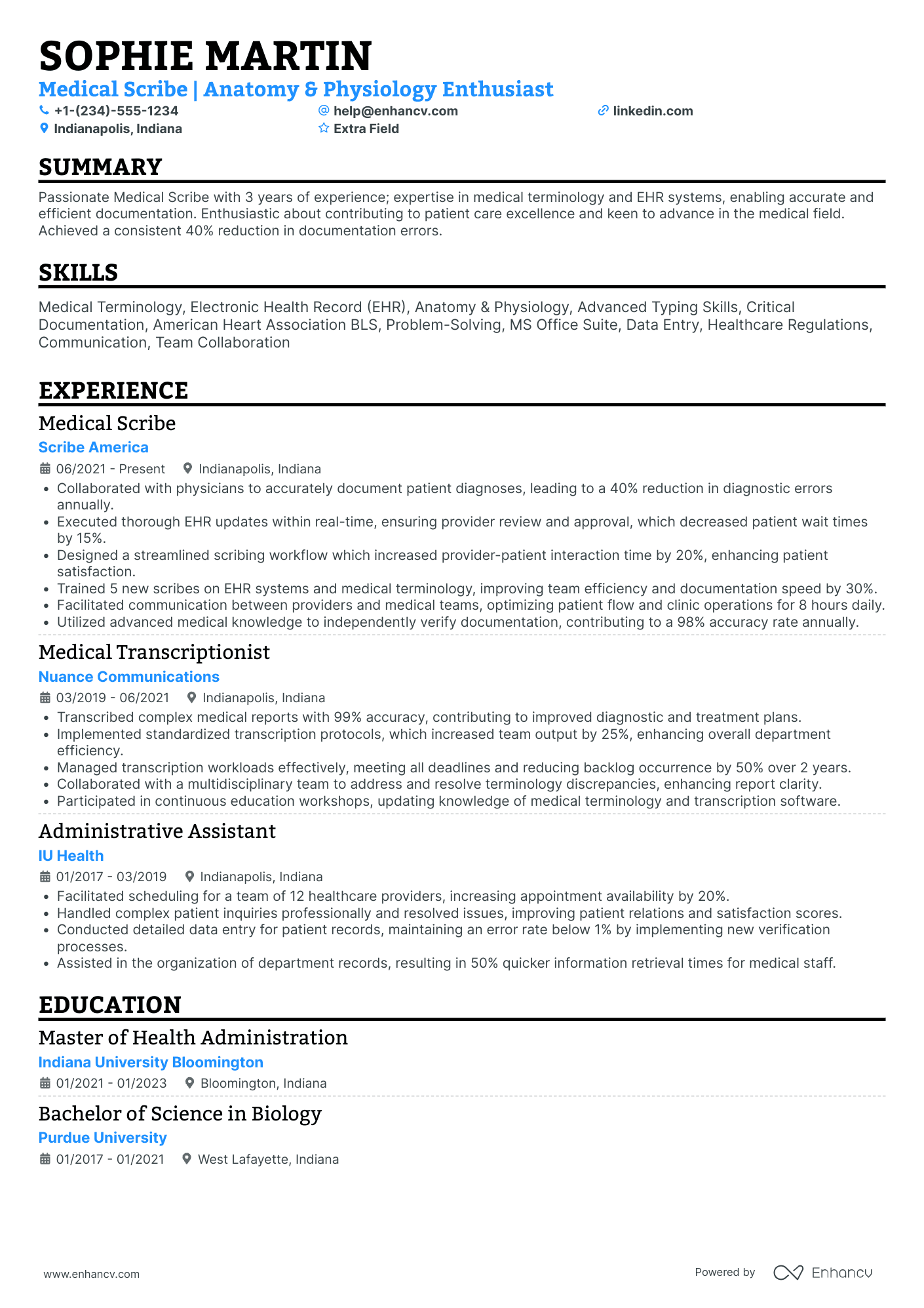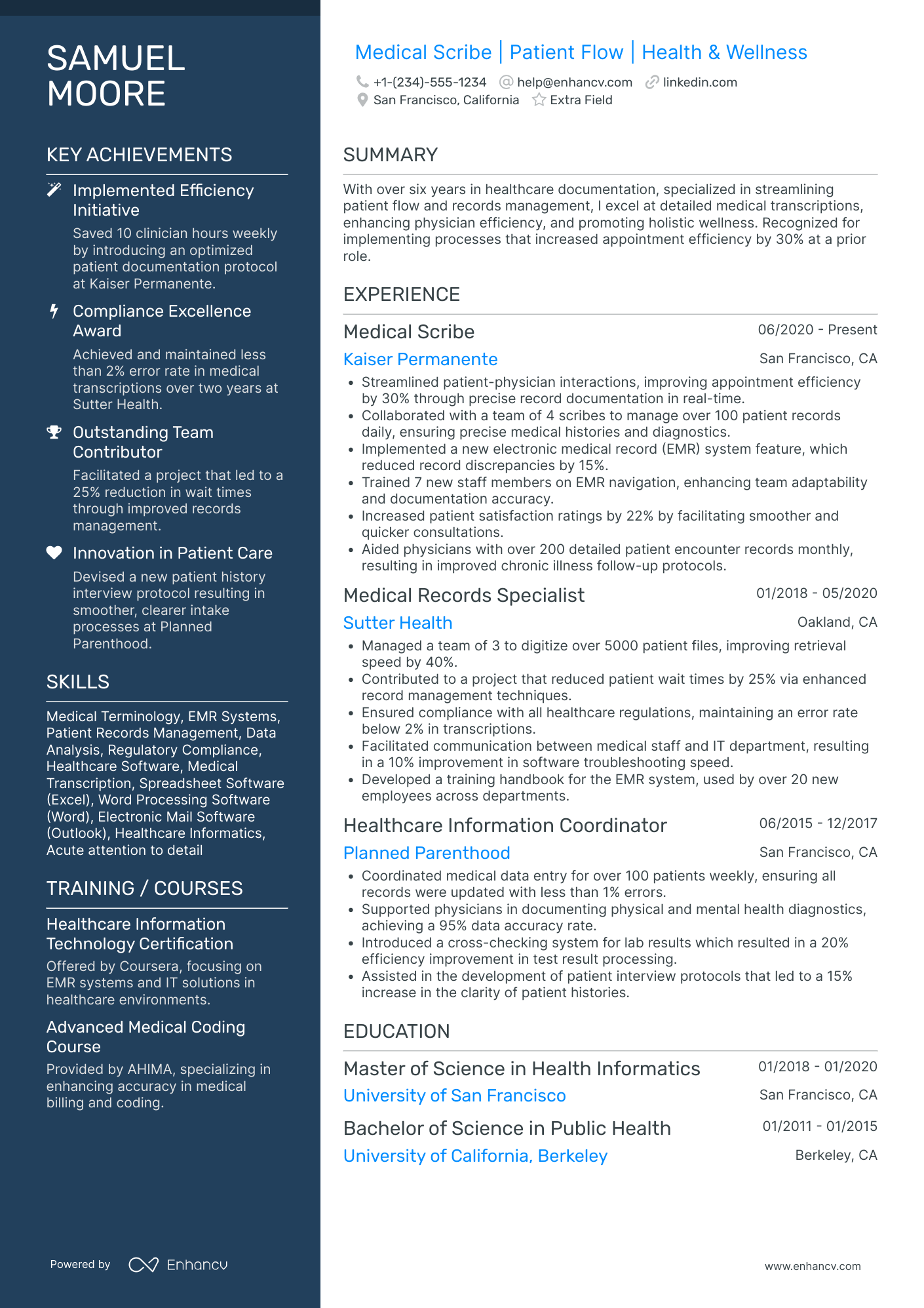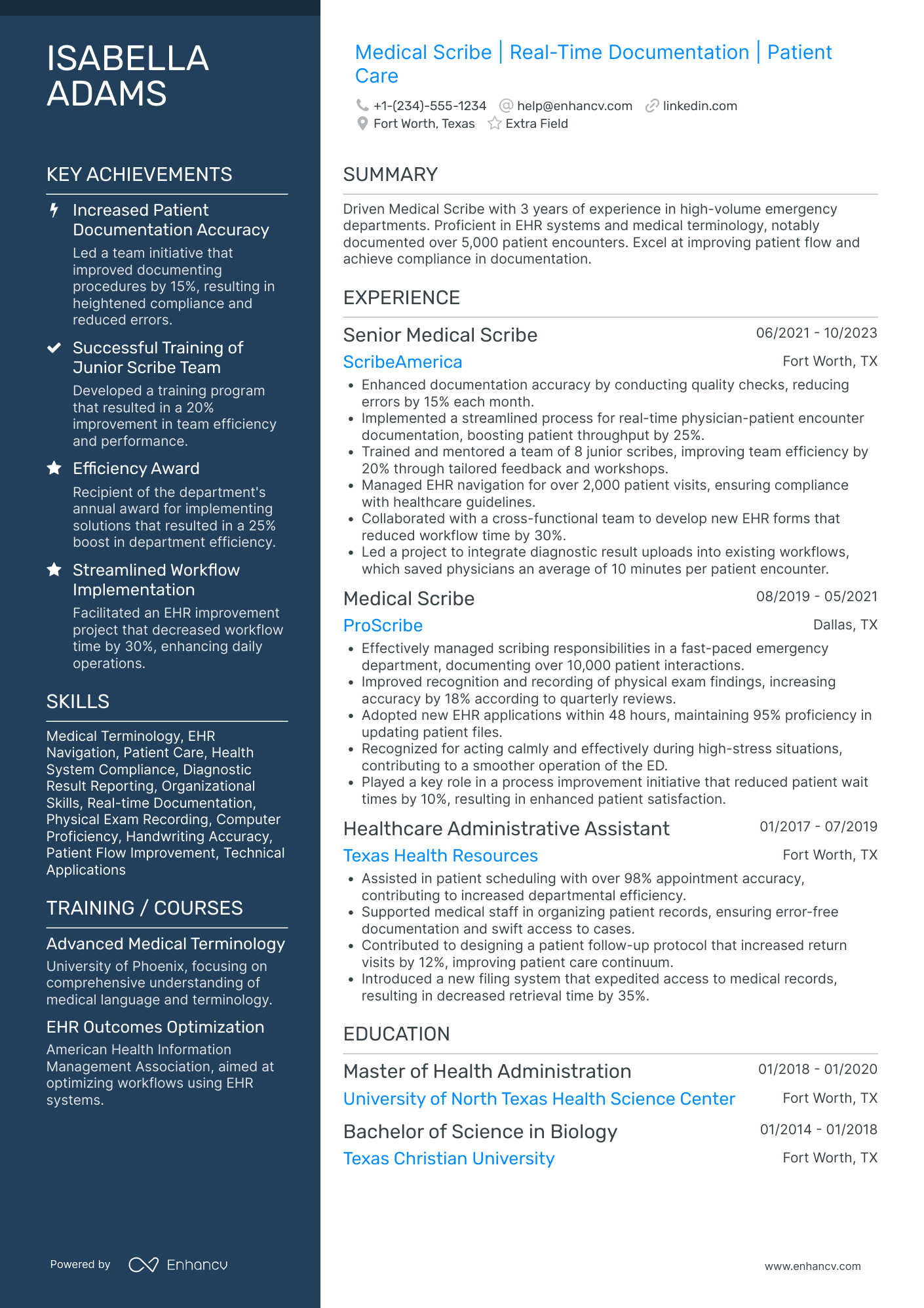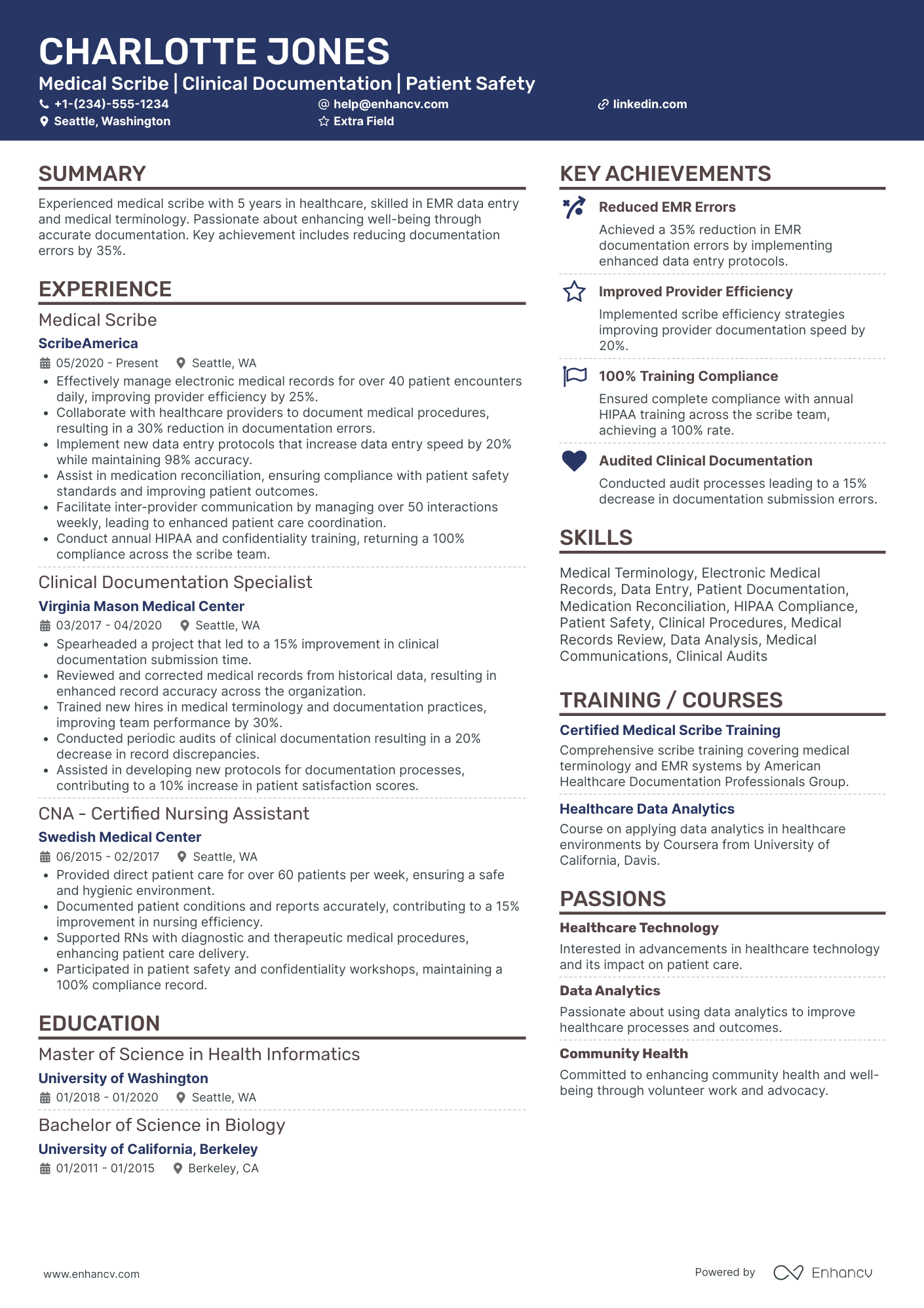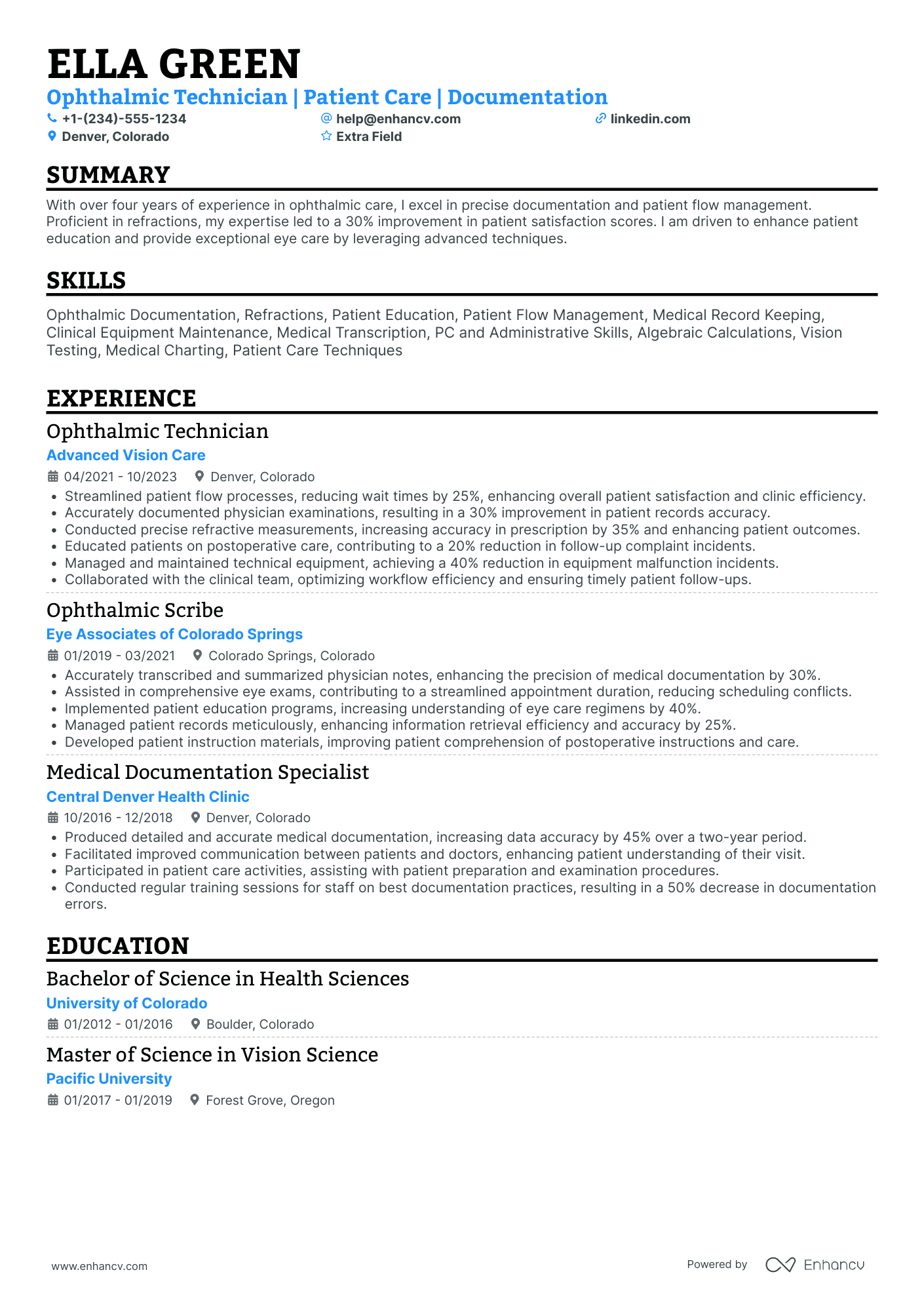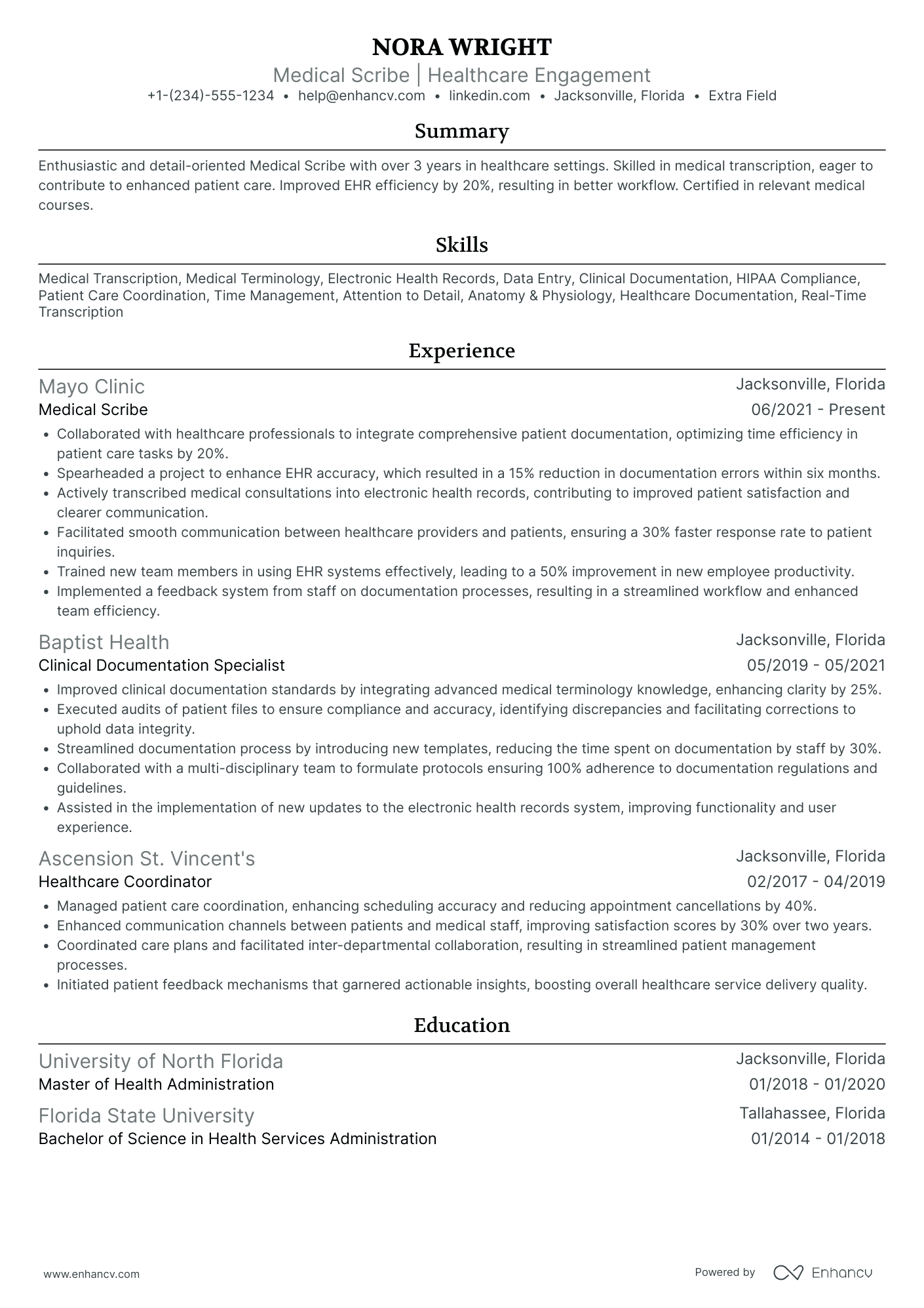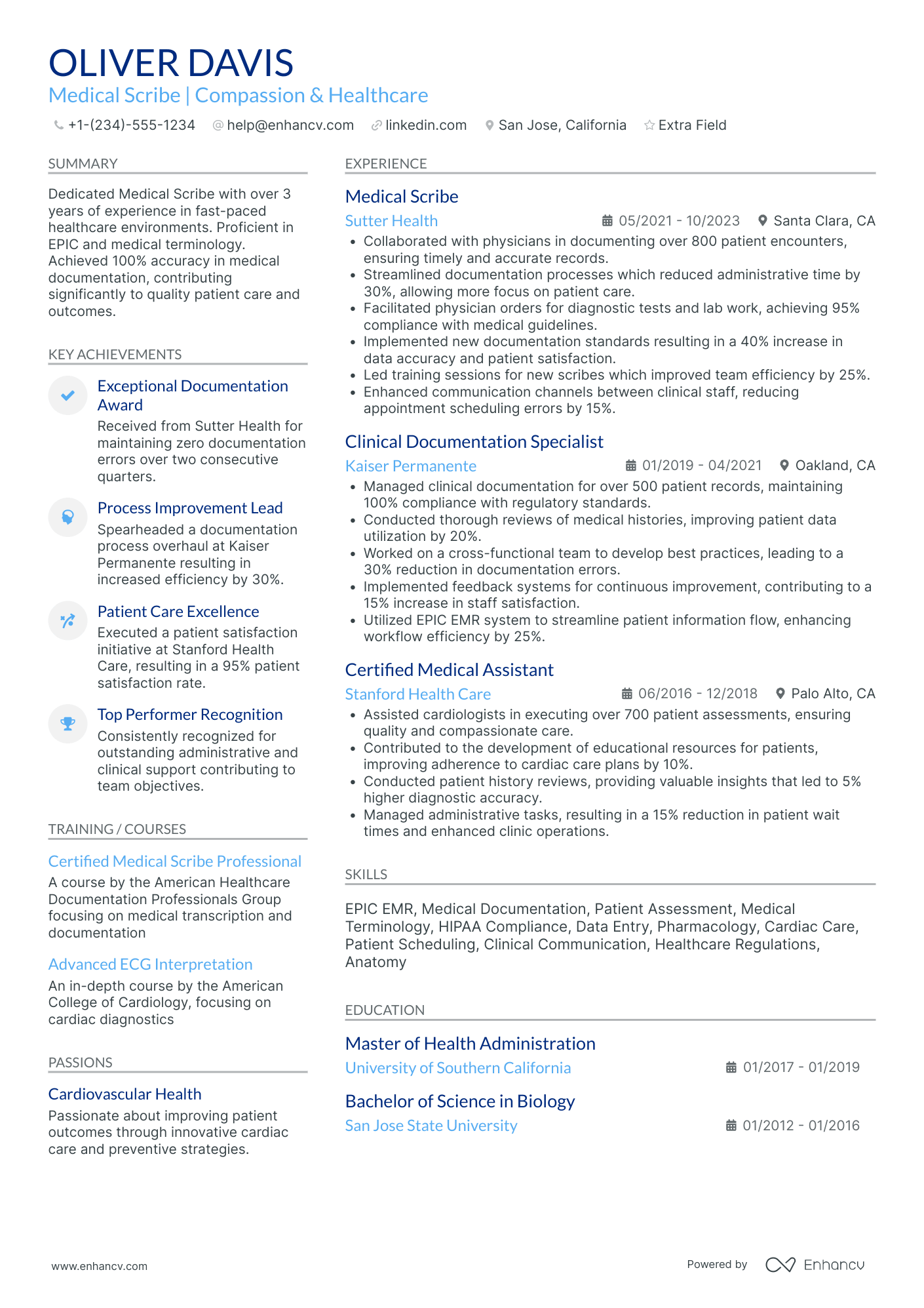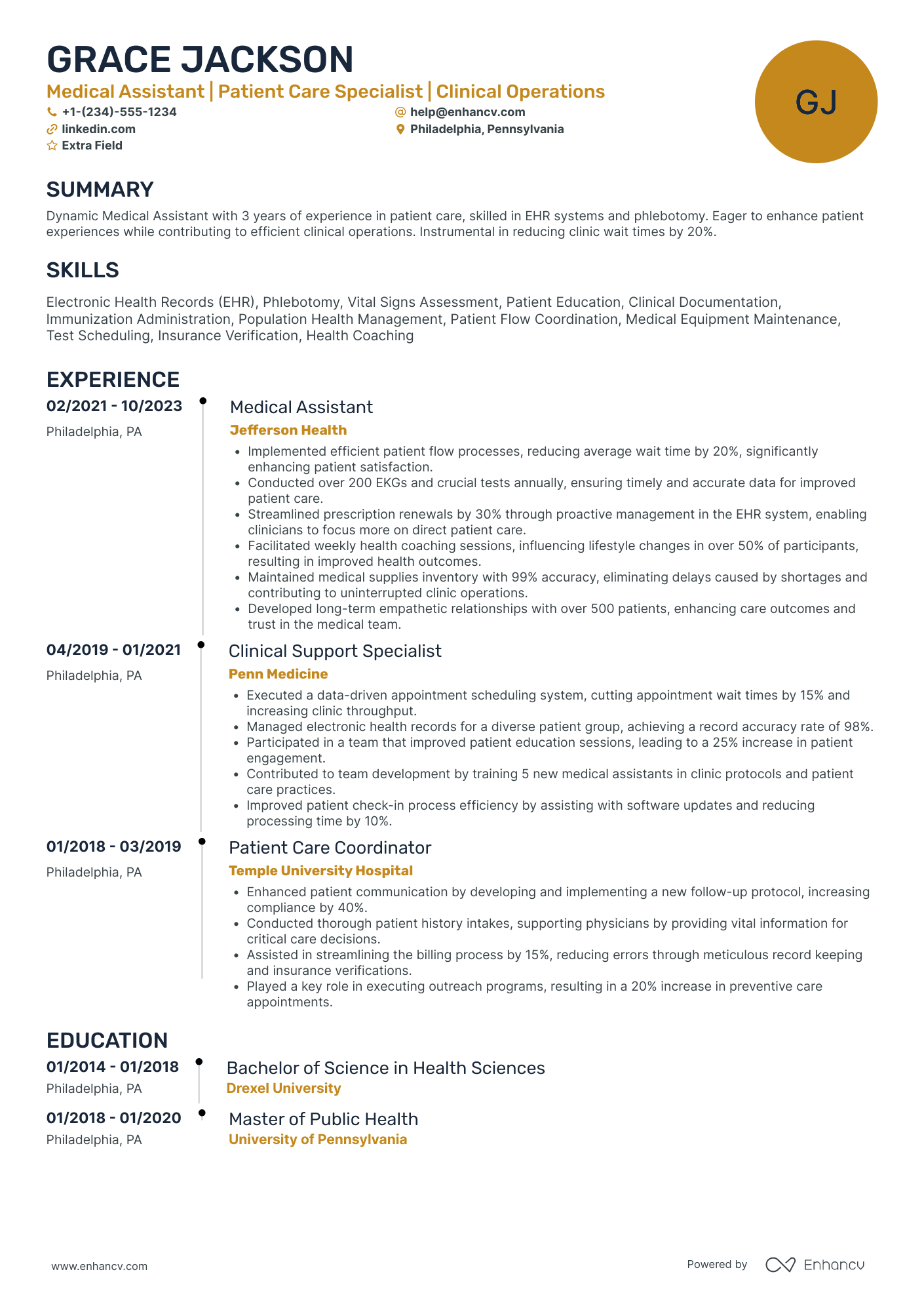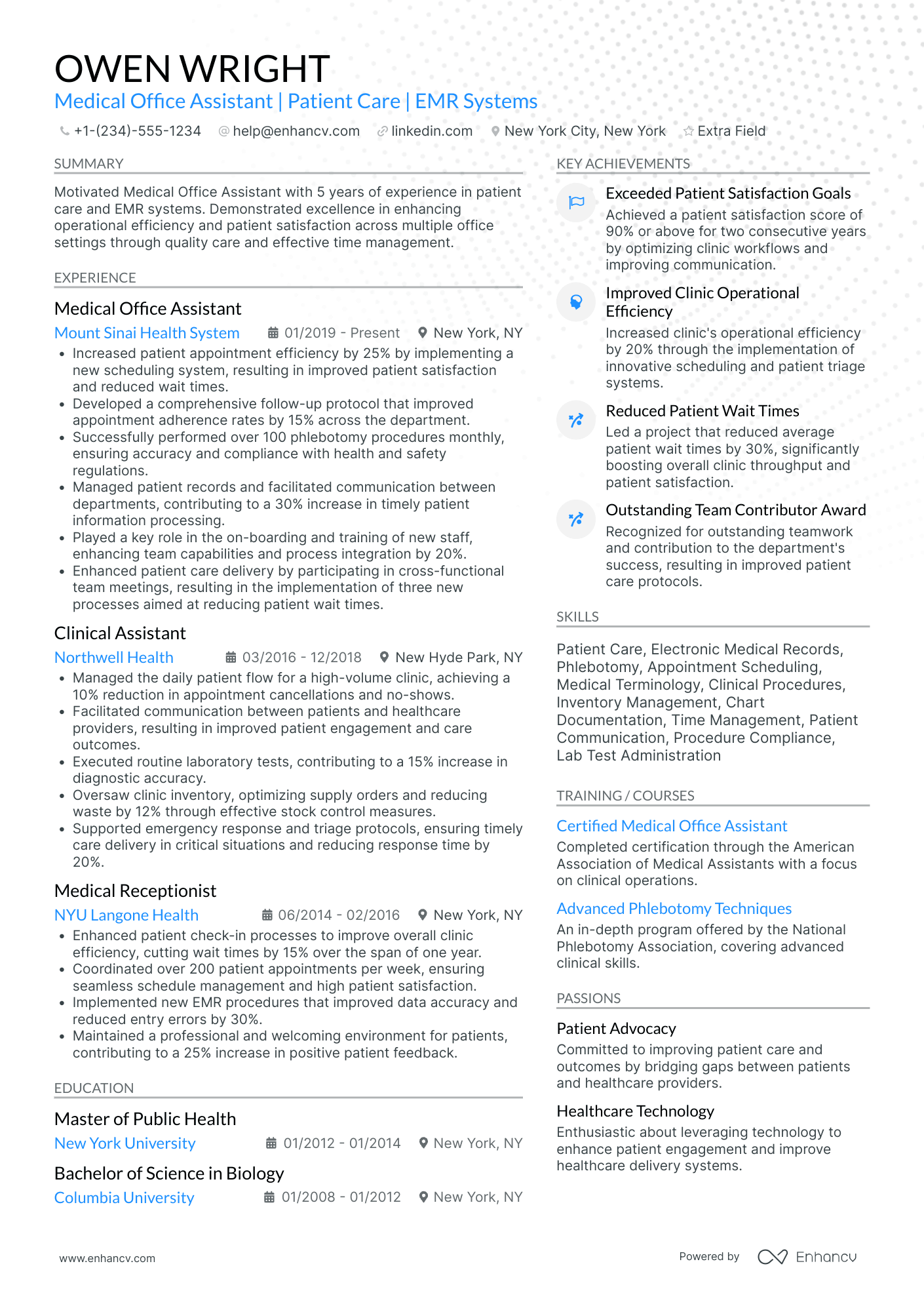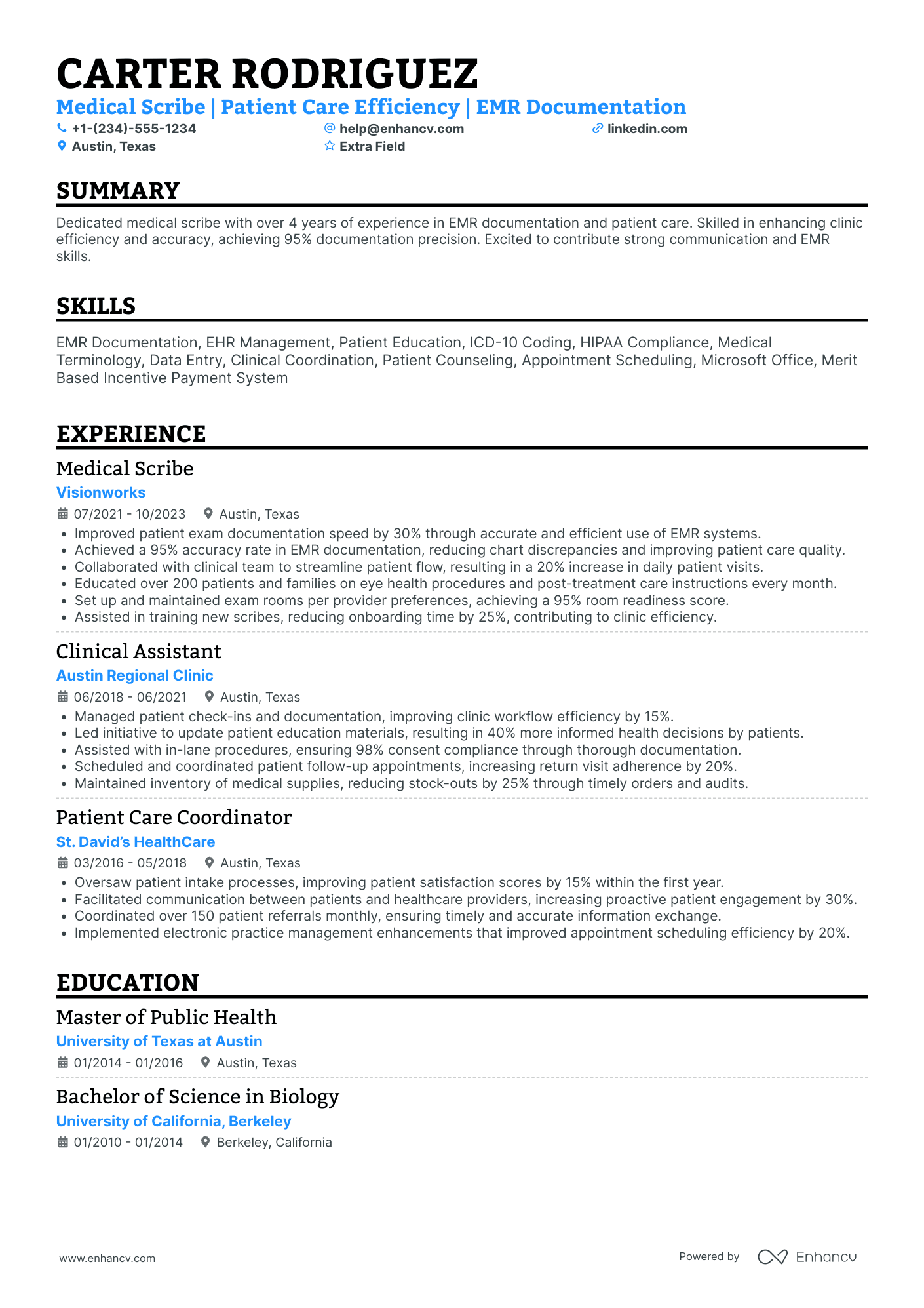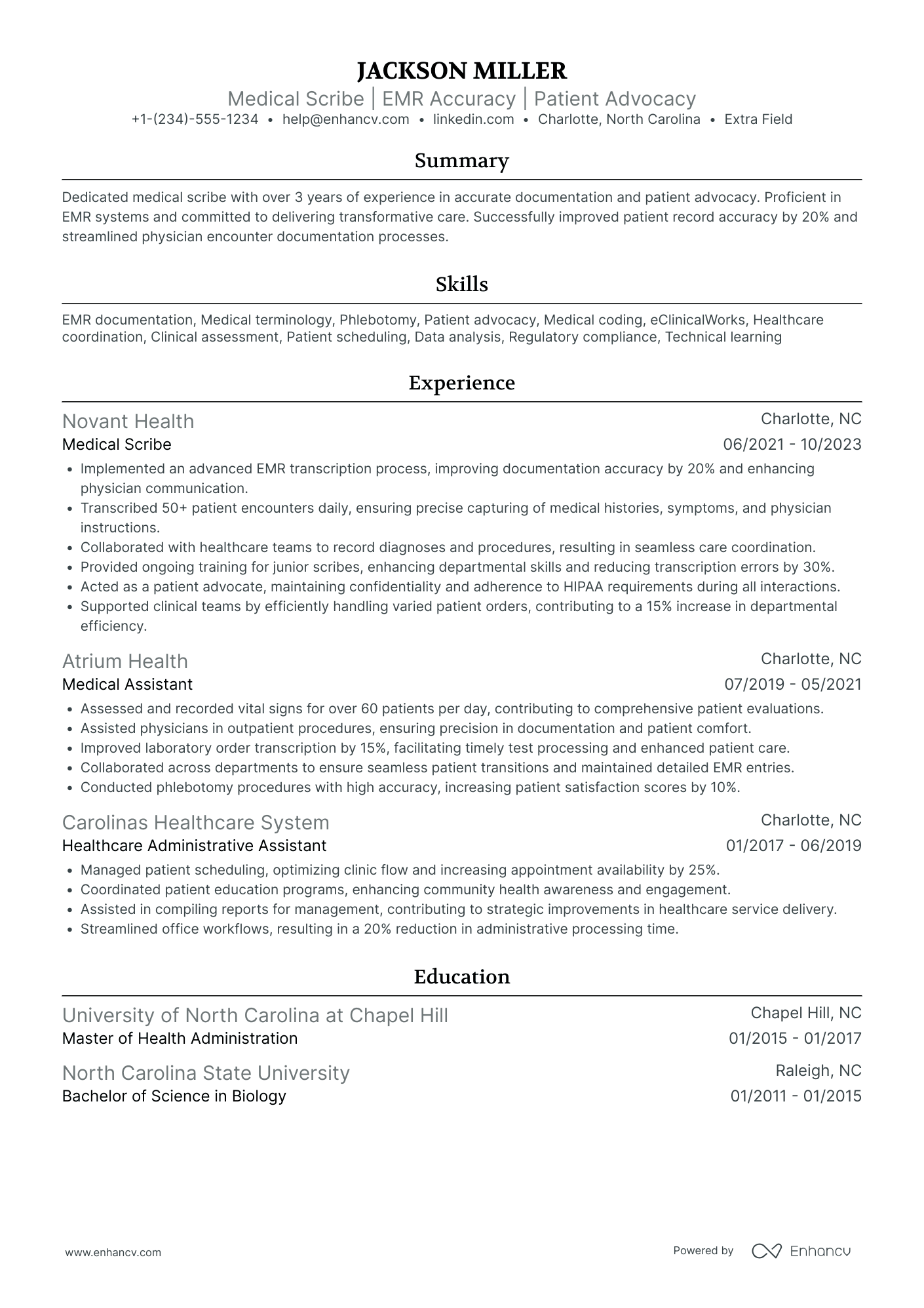As a medical scribe, articulating the breadth of your fast-paced, detail-oriented experience on a resume can be challenging. Our guide provides clear strategies and examples to showcase your medical scribe expertise effectively, ensuring your resume stands out to potential employers.
- Defining the highlights of your medical scribe career through your resume summary, objective, and experience.
- Real-world medical scribe resume samples with best practices on how to stand out amongst the endless pile of candidate resumes.
- Most in-demand medical scribe resume skills and certifications across the industry.
- Standardizing your resume layout, while maintaining your creativity and individuality.
If the medical scribe resume isn't the right one for you, take a look at other related guides we have:
Optimize your medical scribe resume format to pass the recruiters' assessment
You may be wondering just how much time you need to spend on designing your medical scribe resume.
What recruiters are looking for is systematised content that is clear and coherent. Thus, your medical scribe resume needs to answer requirements and why you're the best candidate for the role from the get-go.
Often, a clear layout consists of:
- Sorting your experience in the reverse chronological order - starting with your most recent and relevant roles. This is an excellent choice for more experienced professionals;
- Writing your contact information (e.g. personal phone number and email address) and your portfolio or LinkedIn link in your medical scribe resume header. If you're wondering to include a photo or not, always make sure that it's appropriate for the country you're applying in;
- Use the basic, most important medical scribe resume sections - your experience, education, summary, etc. Use your resume's real estate wisely to tell a compelling, professional story and match job description's keywords;
- Don't go overboard with the length of your resume. One page is absolutely fine if you happen to have under a decade of relevant experience.
Are you still wondering if you should submit your medical scribe resume in PDF or Word format ? The PDF has a few more advantages, as it doesn't change the format and the text can't be altered upon application.
Format matters most when your medical scribe resume is assessed by the Applicant Tracker System (or the ATS).
The ATS parses resumes, looking for specific keywords, skills or experience that match the job description.
P.S. We recently did a study on how the ATS works and were able to demystify three of the biggest misconceptions about how it assesses candidate resumes.
To pass the ATS evaluation, select any of the serif or sans-serif fonts. Popular choices that would help your medical scribe resume stand out include Raleway, Exo 2, Montserrat, etc.
Most traditionalists go for Arial or Times New Roman, but it's often the case that many candidates choose these fonts, and you'd thus lose points on the uniqueness front.
Consider your target market – resumes in Canada, for example, follow different layout conventions.
Upload & Check Your Resume
Drop your resume here or choose a file. PDF & DOCX only. Max 2MB file size.
PRO TIP
List your educational qualifications and certifications in reverse chronological order.
Recruiters' preferred medical scribe resume sections:
- A header with relevant contact information and headline, listing your current job title
- A resume summary or objective pinpointing what is most impressive about your expertise (that aligns with the role)
- An experience section highlighting the specifics of your responsibilities and achievements
- A skills sidebar to intertwine job advert keywords with your unique talents
- An education and certifications sections to serve as further accreditation to your professional experience
What recruiters want to see on your resume:
- Familiarity with medical terminology and abbreviations
- Experience with electronic health record (EHR) systems
- Fast and accurate typing skills
- Strong attention to detail and observational abilities
- Ability to multitask and handle a high-stress, fast-paced environment
What to include in the experience section of your medical scribe resume
The resume experience section is perhaps the most important element in your application as it needs to showcase how your current profile matches the job.
While it may take some time to perfect your medical scribe experience section, here are five tips to keep in mind when writing yours:
- Assess the advert to make a list of key requirements and look back on how each of your past jobs answers those;
- Don't just showcase you know a particular skill, instead, you need proof in the form of tangible results (e.g. numbers, percent, etc.);
- It's perfectly fine to leave off experience items that don't bring anything extra to your skill set or application;
- Recruiters want to understand what the particular value is of working with you, so instead of solely featuring technologies, think about including at least one bullet that's focused on your soft skills;
- Take care with wording each bullet to demonstrate what you've achieved, using a particular skill, and an action verb.
The below medical scribe resume examples can help guide you to curate your professional experience, following industry-leading tips and advice.
- Accurately documented over 200 patient encounters per week, ensuring comprehensive electronic health records for future references and continuity of care.
- Collaborated with physicians to develop and implement a new template for patients' history taking, which reduced appointment times by 15%.
- Trained 5 new scribes on EHR software, medical terminologies, and clinic workflows, enhancing the onboarding process and decreasing training time by 30%.
- Assisted in the management of patient flow in a busy clinic setting, serving approximately 60 patients daily, resulting in a smoother clinical operation and patient experience.
- Conducted extensive chart reviews and data abstraction for quality assurance purposes, identifying key areas for improvement in patient documentation.
- Implemented a real-time documentation feedback system with attending physicians, increasing the accuracy of medical notes by 25%.
- Provided on-the-spot transcriptions for over 30 healthcare providers, allowing for immediate review and sign-off and improving provider efficiency.
- Coordinated with a team of scribes to overhaul the existing clinical documentation process, cutting down on administrative errors by 20%.
- Participated in departmental meetings to discuss improvements in the clinical documentation process, contributing insights from the scribe's perspective that were integral to policy changes.
- Managed the collection and organization of detailed patient histories, noting the improvement of patient satisfaction scores by 10% due to thoroughness and accuracy.
- Served as the primary scribe for specialized care teams in cardiology and emergency medicine, showcasing versatility and depth of medical knowledge.
- Facilitated a reduction in physician clerical workload by 40% through meticulous real-time documentation during patient visits.
- Pioneered the adoption of a digital scribing system that resulted in a 50% decrease in physicians' paperwork time, allowing more focus on patient care.
- Delivered comprehensive support in patient documentation for multiple specialties, including but not limited to orthopedics, pediatrics, and internal medicine.
- Contributed to a 10% increase in daily patient throughput by streamlining the data entry process for medical histories, physicals, and procedure notes.
- Introduced a new shorthand notation system for patient symptoms and diagnoses, reducing documentation time per patient by 8 minutes on average.
- Closely monitored and managed scribe shift schedules, ensuring 100% coverage during peak times in a high-volume urban emergency department.
- Directed the quality assurance program for clinical documentation, yielding a 5% improvement in the accuracy of patient records over a 2-year period.
- Played an instrumental role in the transition from paper charts to an EHR system, training staff and maintaining productivity during the period of changeover.
- Assumed responsibility for capturing detailed clinical notes for an average of 40 patients per day, ensuring no detail was overlooked and every treatment plan was accurately recorded.
- Authored a monthly newsletter on best practices for clinical documentation, which became a respected resource among our network of clinics.
- Excelled in the use of medical technology, facilitating the adoption of speech recognition software which reduced the time for documentation completion by an average of 15% per patient encounter.
- Organized and participated in weekly training sessions for newer scribes, focusing on medical terminology, documentation standards, and EHR navigation.
- Actively engaged with the IT department to troubleshoot and streamline the EHR user experience, resulting in a 30% reduction in technical issues reported by the medical staff.
- Demonstrated expertise in complex medical terminology and pharmacology, supporting oncology specialists in documenting intricate treatment protocols.
- Achieved a zero-error rate in patient charting over a 6-month period by implementing a double-check system before submission of medical notes.
- Spearheaded a peer review process for scribes that led to improved documentation quality and reinforced best practices across the team.
- Integrated into multiple healthcare teams, assisting in the capture of critical patient information for telehealth services during the pandemic, with an average of 70 virtual visits documented per week.
- Initiated a continuous training program for scribes that reduced first-month attrition by 15%, improving overall team stability and performance.
- Developed and maintained an internal wiki for quick reference to physician preferences and common procedures, bolstering documentation speed and compliance.
The following content includes information from "O*NET OnLine" by the U.S. Department of Labor, Employment and Training Administration (USDOL/ETA). Used under the CC BY 4.0 license. The data represents the top responsibilities present on the task lists for medical scribe professionals.
Top Responsibilities for Medical Scribe:
- Assign the patient to diagnosis-related groups (DRGs), using appropriate computer software.
- Compile and maintain patients' medical records to document condition and treatment and to provide data for research or cost control and care improvement efforts.
- Consult classification manuals to locate information about disease processes.
- Enter data, such as demographic characteristics, history and extent of disease, diagnostic procedures, or treatment into computer.
- Identify, compile, abstract, and code patient data, using standard classification systems.
- Maintain or operate a variety of health record indexes or storage and retrieval systems to collect, classify, store, or analyze information.
- Post medical insurance billings.
- Process and prepare business or government forms.
- Process patient admission or discharge documents.
- Protect the security of medical records to ensure that confidentiality is maintained.
Quantifying impact on your resume
- Included the average number of patient charts updated per shift to demonstrate efficiency and workload management.
- Quantified the reduction in documentation errors after implementing a new protocol or system, showing attention to detail and quality improvement.
- Mentioned the number of physicians or healthcare providers supported, indicating ability to work with multiple team members and multitasking skills.
- Listed the percentage of time saved for clinicians by providing real-time charting assistance, reflecting the contribution to operational efficiency.
- Highlighted the total volume of medical encounters documented over a specific period, displaying experience level and productivity.
- Measured the increase in patient satisfaction scores related to accurate and timely documentation, pointing to an understanding of patient-centered care.
- Reported the number of different electronic health record (EHR) systems mastered, suggesting adaptability and technical proficiency.
- Calculated the average time taken to complete a patient chart, underscoring speed along with the ability to maintain a high standard of work.
Action verbs for your medical scribe resume
What can candidates do about their resume, if they have no experience
Job requirements can sometimes be answered by other elements you could make more prominent in your medical scribe resume.
Thus, you'd be substituting your lack of experience with your relevant:
- Education with details of skills you've obtained that align with the job
- Internships and short-term jobs that are once more dedicated to putting your expertise in the spotlight
- Skills section answering basic and - potentially - more specific job qualifications
- Strengths or accomplishments to show the unique value you present, even as a candidate with less or no professional experience in the industry.
Recommended reads:
PRO TIP
List all your relevant higher education degrees within your resume in reverse chronological order (starting with the latest). There are cases when your PhD in a particular field could help you stand apart from other candidates.
Medical scribe resume skills: the essential hard skills and soft skills checklist
Ultimately, your medical scribe resume should hint to recruiters that you possess an array of talents that are indispensable to the role.
For example, listing the technologies and software you're apt at using (or your hard skills) and how you apply them in your day-to-day responsibilities would ensure you meet the technical requirements of the role.
But is this enough to ensure that you make a good impression on recruiters?
Go a step further by detailing the soft skills or personality traits you've attained thanks to your work and life experience.
The best way to balance hard skills and soft skills on your medical scribe resume is by:
- Highlighting up to three of your most noteworthy career accomplishments in a separate section.
- Listing at least one hard skill and one soft skill you've used to solve a particular challenge or problem.
- Feature niche skills and technologies that would help you stand out amongst candidates.
- Think back on the social impact your efforts have had towards improving the work environment - were you able to always maintain a professional ethic, while enhancing the team culture? Write about your contribution to the role, department, or organization itself as a metric of success.
The skills section of your resume provides you with plenty of opportunities to detail your technical and personal traits.
All you have to do is select the talents that best fit your application and expertise. Make note of some of the most prominent hard and soft skills across the industry from our list:
Top skills for your medical scribe resume:
Electronic Health Records (EHR) systems
Medical terminology
Typing speed (minimum 60 WPM)
Transcription software
Microsoft Office Suite
Data entry
Clinical documentation tools
Medical coding (ICD-10, CPT)
Voice recognition software
Remote scribing platforms
Attention to detail
Strong communication skills
Time management
Critical thinking
Empathy
Adaptability
Team collaboration
Problem-solving
Organizational skills
Confidentiality and ethical judgment
Next, you will find information on the top technologies for medical scribe professonals from "O*NET OnLine" by the U.S. Department of Labor, Employment and Training Administration (USDOL/ETA). Used under the CC BY 4.0 license.
Top technologies for Medical Scribe’s resume:
- eClinicalWorks EHR software
- Henry Schein Dentrix
- Eko
- Microsoft SQL Server
- Structured query language SQL
PRO TIP
Listing your relevant degrees or certificates on your medical scribe resume is a win-win situation. Not only does it hint at your technical capabilities in the industry, but an array of soft skills, like perseverance, adaptability, and motivation.
Including your education and certification on your medical scribe resume
The significance of your resume education section is paramount. It can show your diverse talents and experiences that are relevnt to the position.
- Incorporate educational qualifications, mentioning the institution and period.
- If you're on your academic journey, pinpoint your expected completion date.
- Opt for leaving out degrees that don't serve the job's purpose.
- Provide an overview of your educational experiences if it spotlights your milestones.
When recruiting for medical scribe roles, candidates with relevant education and certification definitely stand out amongst competitors.
Showcase your academic background in the best way possible by:
- Listing all degrees and certifications that are part of the candidate qualifications in the medical scribe advert
- Including any extra certificates, if they make sense to your application
- Not going over the top in details - the certificate name, institution, and dates are enough
- If you're in the process of obtaining a degree or certificate that's relevant to the job, include your expected graduation/certification dates
The education and certification sections help back up your application with years of experience in the industry or niche.
Select some of the most cutting-edge or applicable credentials for your next medical scribe application from our list:
The top 5 certifications for your medical scribe resume:
- Certified medical scribe Professional (CMSP) - American Healthcare Documentation Professionals Group
- Certified medical scribe Specialist (CMSS) - American College of Clinical Information Managers
- Medical scribe Certification Exam (MSCE) - American College of medical scribe Specialists
- Certified Clinical Medical Assistant (CCMA) - National Healthcareer Association
- Certified Medical Administrative Assistant (CMAA) - National Healthcareer Association
The content below includes information from "O*NET OnLine" by the U.S. Department of Labor, Employment and Training Administration (USDOL/ETA). Used under the CC BY 4.0 license. The data represents the top associations for medical scribe professionals.
Top US associations for a Medical Scribe professional
- AAPC
- American Association of Healthcare Administrative Management
- American Health Information Management Association
- American Medical Association
- American Medical Informatics Association
PRO TIP
If you're in the process of obtaining your certificate or degree, list the expected date you're supposed to graduate or be certified.
Recommended reads:
The medical scribe resume summary or objective: integrating keywords, achievements, and more
Deciding whether to include a resume summary or an objective in your medical scribe resume is crucial. Both serve as key introductory elements at the top of your resume, encapsulating your profile in up to five sentences and incorporating relevant keywords from the job advert.
Here are the key differences between the two:
- The resume summary focuses on aligning your achievements and experience with the job requirements. It provides recruiters with a snapshot of your expertise, helping you stand out as an ideal candidate for the role.
- The resume objective, on the other hand, centers on your career goals and aspirations, detailing how the role aligns with your career progression. It's particularly suitable for candidates with less professional experience or those new to the job market.
Below are examples demonstrating best practices in utilizing the resume summary and/or objective to make a strong first impression with your medical scribe resume.
Resume summaries for a medical scribe job
- With 3 years of dedicated experience, a keen grasp on medical terminology, and a proven track record of accurately documenting patient encounters, this adept medical scribe is poised to bring skillful support to a fast-paced healthcare environment. Major achievements include streamlining the charting process, reducing errors by 20% at City Health Clinic.
- Seasoned paramedic transitioning into medical scribing with 5 years of front-line medical experience, inclusive of comprehensive patient care and emergency response management. Exceptional at quick data capture and well-versed in EHR systems. Spearheaded a cross-training program that improved the response times for critical patients by 15%.
- Former legal secretary with a decade of experience in fast-paced, information-intensive environments, now eager to apply translatable skills to medical scribing. Familiar with multi-tasking under pressure, maintaining impeccable attention to detail, and committed to facilitating seamless workflow for healthcare professionals.
- A biology graduate with a passion for patient care and enthusiasm for medical research seeks to leverage a strong scientific foundation and excellent communication skills to excel in medical scribing. Eager to contribute to a team that values precision and efficiency in clinical documentation.
- As a recent Certified medical scribe Professional (CMSP), I am eager to begin my career in healthcare documenting, aspiring to facilitate the physician's workload by providing accurate and timely documentation. My objective is to be a catalyst in creating a more efficient clinical workflow to enhance patient care.
- Enthusiastic and quick-learning individual with a B.S. in Health Sciences aims to utilize strong attention to detail, first-hand clinical shadowing experiences, and proficiencies in health information systems to become an asset to a medical scribe team, ensuring high-quality patient documentation and support to healthcare professionals.
Optimize your resume summary and objective for ATS
Drop your resume here or choose a file.
PDF & DOCX only. Max 2MB file size.
Average salary info by state in the US for medical scribe professionals
Local salary info for Medical Scribe.” Source: My Next Move, National Center for O*NET Development. Accessed 10/15/2024
| State | Average Salary (in USD) |
|---|---|
| US National Average | $48,780 |
| California (CA) | $53,740 |
| Texas (TX) | $44,180 |
| Florida (FL) | $44,210 |
| New York (NY) | $59,050 |
| Pennsylvania (PA) | $46,160 |
| Illinois (IL) | $49,900 |
| Ohio (OH) | $48,010 |
| Georgia (GA) | $48,880 |
| North Carolina (NC) | $46,440 |
| Michigan (MI) | $47,810 |
Taking your medical scribe resume to the next level with these four additional resume sections
Your medical scribe resume can feature a variety of skills (both hard and soft) in diverse sections. Choose those that align best with the job requirements and reflect your suitability for the company culture.
Consider these four additional resume sections recommended by our experts:
- Languages - State any languages you are proficient in and your level of proficiency. This demonstrates your commitment to communication and potential for international growth.
- Projects - Highlight up to three significant projects you've completed outside of work, showcasing skill development. Include a link to your project portfolio in the medical scribe resume header, if applicable.
- My Time - How you allocate your time outside work can indicate your organizational skills and cultural fit within the company.
- Volunteering - Detail causes you're passionate about, roles you've held, and achievements in volunteering. Such experiences likely have honed a range of soft skills crucial for your dream job.
Key takeaways
- Impactful medical scribe resumes have an easy-to-read format that tells your career narrative with highlights;
- Select a resume summary or objective, depending on what sort of impression you'd like to leave and if your accomplishments are relevant to the job;
- If you don't happen to have much industry expertise, curate additional gigs you've had, like contracts and internships, to answer how your experience aligns with the medical scribe job;
- Be specific about the hard and soft skills you list on your resume to define your niche expertise and outcomes of using those particular skills;
- Always tailor your resume for each medical scribe application to ensure you meet all job requirements.
Medical Scribe resume examples
By Experience
By Role
